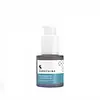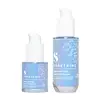What's inside
What's inside
 Key Ingredients
Key Ingredients

 Benefits
Benefits

 Concerns
Concerns

No concerns
 Ingredients Side-by-side
Ingredients Side-by-side

Water
Skin ConditioningMethylpropanediol
SolventPentylene Glycol
Skin Conditioning1,2-Hexanediol
Skin ConditioningLecithin
EmollientAmmonium Acryloyldimethyltaurate/Vp Copolymer
Betaine
HumectantSpirulina Platensis Extract
Skin ProtectingAdenosine
Skin ConditioningXanthan Gum
EmulsifyingEthylhexylglycerin
Skin ConditioningCitric Acid
BufferingChlorella Vulgaris Extract
Skin ConditioningTocopherol
AntioxidantHaematococcus Pluvialis Extract
AntioxidantSodium Benzoate
MaskingPhytic Acid
Potassium Sorbate
PreservativeButylene Glycol
HumectantBeta-Sitosterol
Emulsion StabilisingSqualane
EmollientAllantoin
Skin ConditioningWater, Methylpropanediol, Pentylene Glycol, 1,2-Hexanediol, Lecithin, Ammonium Acryloyldimethyltaurate/Vp Copolymer, Betaine, Spirulina Platensis Extract, Adenosine, Xanthan Gum, Ethylhexylglycerin, Citric Acid, Chlorella Vulgaris Extract, Tocopherol, Haematococcus Pluvialis Extract, Sodium Benzoate, Phytic Acid, Potassium Sorbate, Butylene Glycol, Beta-Sitosterol, Squalane, Allantoin
Water
Skin ConditioningAmmonium Polyacryloyldimethyl Taurate
Emulsion StabilisingButylene Glycol
HumectantHydrogenated Lecithin
EmulsifyingPotassium Methoxysalicylate
BleachingPhenoxyethanol
PreservativeDipentaerythrityl Hexa C5-9 Acid Esters
Skin ConditioningNeopentyl Glycol Diheptanoate
EmollientPolymethylsilsesquioxane
Polyglyceryl-4 Caprate
EmulsifyingAroma
Benzotriazolyl Dodecyl P-Cresol
UV AbsorberBHT
AntioxidantDisodium EDTA
Ethylhexylglycerin
Skin ConditioningMalus Domestica Fruit Cell Culture Extract
Skin ConditioningXanthan Gum
EmulsifyingGlycerin
HumectantCaprylyl Glycol
EmollientLecithin
EmollientDiamond Powder
AbrasiveGlyceryl Caprylate
EmollientLactic Acid/Glycolic Acid Copolymer
Skin ConditioningPhenylpropanol
MaskingChlorella Vulgaris Extract
Skin ConditioningPolyvinyl Alcohol
Heptapeptide-15 Palmitate
Skin ConditioningWater, Ammonium Polyacryloyldimethyl Taurate, Butylene Glycol, Hydrogenated Lecithin, Potassium Methoxysalicylate, Phenoxyethanol, Dipentaerythrityl Hexa C5-9 Acid Esters, Neopentyl Glycol Diheptanoate, Polymethylsilsesquioxane, Polyglyceryl-4 Caprate, Aroma, Benzotriazolyl Dodecyl P-Cresol, BHT, Disodium EDTA, Ethylhexylglycerin, Malus Domestica Fruit Cell Culture Extract, Xanthan Gum, Glycerin, Caprylyl Glycol, Lecithin, Diamond Powder, Glyceryl Caprylate, Lactic Acid/Glycolic Acid Copolymer, Phenylpropanol, Chlorella Vulgaris Extract, Polyvinyl Alcohol, Heptapeptide-15 Palmitate
 Reviews
Reviews

Ingredients Explained
These ingredients are found in both products.
Ingredients higher up in an ingredient list are typically present in a larger amount.
Butylene Glycol (or BG) is used within cosmetic products for a few different reasons:
Overall, Butylene Glycol is a safe and well-rounded ingredient that works well with other ingredients.
Though this ingredient works well with most skin types, some people with sensitive skin may experience a reaction such as allergic rashes, closed comedones, or itchiness.
Learn more about Butylene GlycolChlorella Vulgaris Extract comes from a green microalga. It is hydrating and contains antioxidants.
Studies also show Chlorella Vulgaris may help in rebuilding collagen and elastin. This ingredient is made up of lipids, carbohydrates, and chlorophyll.
Fun fact: This ingredient is commonly used as food additive in Japan.
Learn more about Chlorella Vulgaris ExtractEthylhexylglycerin (we can't pronounce this either) is commonly used as a preservative and skin softener. It is derived from glyceryl.
You might see Ethylhexylglycerin often paired with other preservatives such as phenoxyethanol. Ethylhexylglycerin has been found to increase the effectiveness of these other preservatives.
Lecithin is a term for a group of substances found in the cell membranes of plants, animals, and humans. They are made up of mixture of phospholipids.
This ingredient has emollient and emulsifying properties.
As an emollient, lecithen helps soften the skin and creates a barrier to keep moisture in.
As an emulsifier, it also helps prevent water and oil ingredients from separating. Lecithin can also help ingredients be better absorbed by the skin.
This is because the phospholipids in lecithin produce liposomes. Liposomes help other ingredients get through the skin barrier.
Depending on the source of this ingredient, lecithin may not be fungal acne safe. This is because some sources of lecithin come from soybean oil, which may feed the malassezia yeast that feeds fungal acne.
We recommend reaching out to the brand you are purchasing from to inquire about the source of their lecithin.
Some other names for this ingredient include soy lecithin and deoiled soy lecithin.
Learn more about LecithinWater. It's the most common cosmetic ingredient of all. You'll usually see it at the top of ingredient lists, meaning that it makes up the largest part of the product.
So why is it so popular? Water most often acts as a solvent - this means that it helps dissolve other ingredients into the formulation.
You'll also recognize water as that liquid we all need to stay alive. If you see this, drink a glass of water. Stay hydrated!
Learn more about WaterXanthan gum is used as a stabilizer and thickener within cosmetic products. It helps give products a sticky, thick feeling - preventing them from being too runny.
On the technical side of things, xanthan gum is a polysaccharide - a combination consisting of multiple sugar molecules bonded together.
Xanthan gum is a pretty common and great ingredient. It is a natural, non-toxic, non-irritating ingredient that is also commonly used in food products.
Learn more about Xanthan Gum